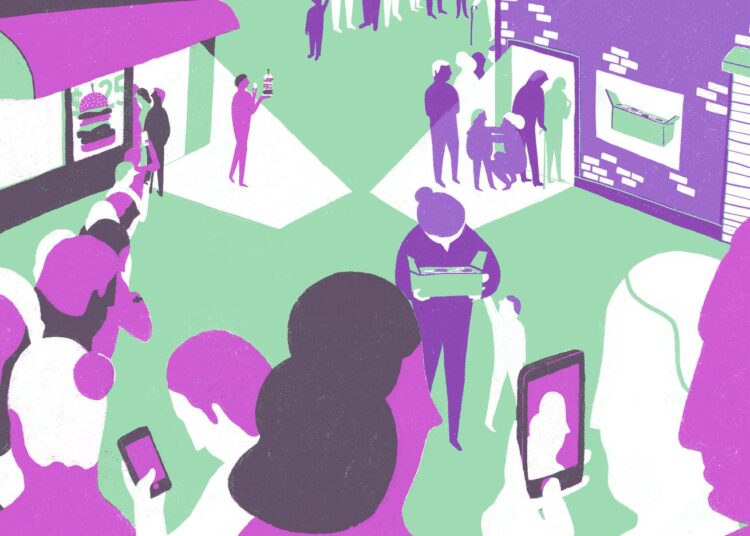Our increased interest in food has, in some ways, made it harder for some people to get enough to eat
No one has to tell you that right now is an incredibly expensive time to eat. Whether you’re at the grocery store, where prices have risen nearly 6 percent over the last year, or eating at your favorite restaurant, everyone’s felt the pinch of high food prices. But the impact of high food prices is disproportionately felt among low-income families, who spend as much as 30 percent of what they earn on food every single month.
As a result, more than 44 million Americans don’t have enough food to eat. That burden hits children especially hard. And the country’s food banks say that the demand for their services is dramatically higher this year than in years past. In the depths of the COVID-19 pandemic, when unemployment skyrocketed and millions struggled to put food on the table, the federal government’s aid programs pumped billions of dollars into food banks and other charities to help meet the unprecedented need. Those programs have since ended, leaving food banks to meet this increased demand with fewer resources.
Which means that it’s time for everyone, especially those of us who deeply care about restaurants, to step up in a big way. Even if you’re dealing with your own personal budget crisis — and frankly, who among us isn’t? Times are tough! — a few dollars in the hands of a food bank can be transformative for a person who’s food insecure. You may not be able to solve the swirling hellscape that is late capitalism in America, but you can put your spare change to good use.
Why food banks?
Food banks are uniquely qualified to address America’s hunger crisis. They’ve long accomplished the boots-on-the-ground work, despite years of deep cuts to food assistance programs on both a state-by-state and national level. Food banks receive federal funding, but donations from individuals make up the majority of the budget used to feed people at soup kitchens, food pantries, and meal programs across the country.
These food banks have finely honed the science of fighting hunger, deftly targeting those most in need. They’ve created programs to ensure that senior citizens can access nutritionally sound meals that keep them both satiated and help prevent illnesses like high blood pressure, heart disease, and diabetes. In 2022 alone, Feeding America’s BackPack Program distributed 54 million shelf-stable, easy-to-prepare snacks and meals to children to keep them fed on weekends.
As people with a vested interest in food culture, it’s important to balance our appetites for coveted restaurant reservations with an equally passionate commitment to food justice. For better or worse, foodie culture is now popular culture, and that’s come with a whole lot of negative unintended consequences. Restaurants have played a huge role in the gentrification of countless neighborhoods, forcing families and long-established small businesses alike out of their homes as the hip, moneyed crowds moved into Bushwick, Austin, Nashville, and Charleston. Sometimes, those in poverty live just steps away from the county’s buzziest restaurants. And foods that were once cheap — tacos, hot chicken, and collard greens — have transformed into luxury items, driving up their price.
Put simply, our increased interest in food has, in some ways, made it harder for some people to get enough to eat. It’s our responsibility to help close the gap.
What’s the best thing to donate to a food bank?
It isn’t as simple as just picking up a few cans of food and dropping them off at a pantry. You have to give money — as much as you can afford, and frequently. Because food banks buy in bulk, they wield a great deal more purchasing power than an individual person at a grocery store. Depending on your location, food banks can provide between two to eight meals to people in need with a single dollar, about what you’d spend on a single can of beans.
With individual donations, food banks can pair your 10 or 15 bucks with corporate grants, federal aid dollars, and negotiated pricing on food items to squeeze the most out of every single dollar. Canned goods can’t purchase the trucks, gasoline, and manpower required to pack and ship the thousands of pounds of food distributed each month, but cash can. When you give money, you maximize your impact.
Plenty of people view donating to food banks (or any other charity) as a way to dispose of their unwanted garbage. Donating the decades-old canned goods from your pantry isn’t just a dick move that lacks respect for the people you’re supposedly trying to help, it also costs food banks — who are responsible for sorting and disposing of items they can’t use — time and money. These “gifts” can also have negative unintended effects, like when food bank patrons receive food that is moldy, infested with worms, or riddled with bacteria.
Thanks to the wonders of technology, it is now ridiculously easy to give money to a food bank that serves your local community. Most accept online donations, and many offer the ability to set up a recurring donation automatically drafted from your bank account or credit card every month. If you want to further maximize your impact, many corporate employers offer charitable donation matching (up to a percentage) that doesn’t cost you a dime.
This time of year, just before Thanksgiving and Christmas, is when hunger generally comes into focus, evidenced by the canned food drives and turkey giveaways that will crop up over the coming weeks. Donations to food banks peak in November and December, and they are necessary, but hunger is a year-round problem that requires constant attention.
But you don’t have to schlep boxes from the grocery store or set up a canned food drive. Just figure out how much you spend at restaurants, take a percentage you can comfortably afford, and give.
Vance Lump is an illustrator in the Pacific Northwest.














